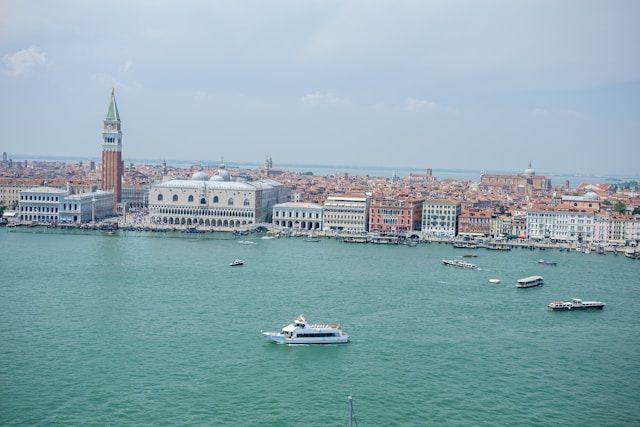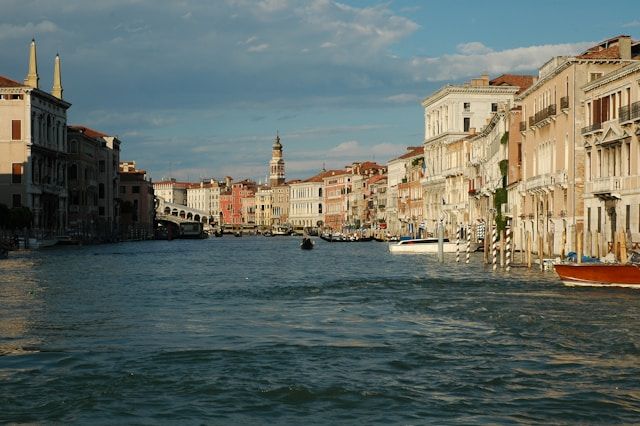Hey dear traveler, today we're taking you on a journey beneath the surface of La Serenissima. Have you ever heard that Venice is built on logs?
It may sound unbelievable, but it's absolutely true! In this comprehensive guide on Venice built on logs of wood on stilts by Venice Insider Guide, we’ll uncover the secrets hidden beneath the canals and the world’s most iconic palaces.
Get ready to explore the very foundation (literally!) of this one-of-a-kind city.
Venice built on logs: from myth to engineering marvel

Venice, the famous floating city, has been an architectural and engineering puzzle for centuries. But how can such a complex city stand on the muddy lagoon floor of the Venetian Lagoon, facing the Adriatic Sea, and remain stable for more than a thousand years?
Let’s dive in together and explore the submerged world of Venice’s foundations—a world of wooden piles, brackish water, Istrian stone, and extraordinary human ingenuity.
A city on mud, logs, and ambition
Venice was originally founded on marshy soil and sandy islands—hardly the best place to build a metropolis. But it was precisely this unstable setting that sparked the brilliance of the first Venetians.
- Wooden foundations were driven into the lagoon floor, deep enough to reach more compact and solid layers.
- A submerged structure often called an “upside down forest” was created beneath each building.
- Weight was distributed using clever construction techniques and Istrian stone, a dense, waterproof limestone.
This engineering ensured the foundation stability necessary for the city’s development into a thriving urban center.
Was Venice built on wooden logs? Yes
Yes, that's right: Venice is built on wooden logs. The city, founded in the 5th century by refugees fleeing barbarian invasions, rises on an archipelago of 118 islands in the Venetian lagoon. But how can buildings, churches, and palaces stand on such marshy ground? The answer: logs, piles, and human ingenuity.
The ancient Venetians not only faced an apparently impossible challenge—they overcame it with a system that has lasted for over a thousand years. Thanks to the strategic use of wood, sand, Istrian stone, and water, Venice still stands today as a marvel of ancient engineering.
Venice built on logs: characteristics

The wooden logs used in Venice were driven vertically into the muddy ground of the lagoon. On average, each building rests on hundreds, if not thousands, of these piles.
The logs weren’t just placed randomly—they follow a precise structural logic:
- Depth: the piles were driven deep enough to reach firmer layers beneath the mud.
- Density: the piles are placed close together to ensure stability.
- Multiple layers: above the logs, a wooden platform and then stones were placed, forming the base for structures.
The result is a solid foundation that has resisted centuries of moisture, saltwater, and geological movements.
Venice built on wood: description
Imagine thousands of wooden piles driven side-by-side beneath every Venetian building. On top of them, horizontal wooden beams and blocks of Istrian stone. This white, water-resistant stone from nearby Croatia was key to insulating against moisture.
Above this "invisible layer" stands the Venice we know: St. Mark’s Basilica, the Doge’s Palace, the Rialto Bridge. All are supported by this ancient technique that harnesses the natural physics of the lagoon and the durability of wood.
Venice built on logs on wood: what to know
Here are a few facts every Venice lover should know:
- Most of the piles date back to the Middle Ages, though some go as far back as the Byzantine era.
- Venice isn't sinking because of the piles, but due to other factors like groundwater extraction (now banned) and rising sea levels.
- The brackish water actually helps preserve the wood.
Is Venice built on stilts? Yes
Yes, Venice is indeed built on stilts! The term "stilts" may conjure images of wooden poles sticking out of the water, but in Venice, it refers to the massive wooden piles driven deep into the mud beneath the city. These vertical logs form a man-made foundation stable enough to support stone buildings.
The romantic notion of Venice floating is misleading. It's not floating—it's standing strong on a sophisticated system of stilts hidden beneath the water.
How many wooden piles in Venice
It’s estimated that Venice rests on approximately 10 million wooden piles. For example:
- The Rialto Bridge alone is supported by over 12,000 wooden poles.
- The Basilica of Santa Maria della Salute stands on over 1 million poles.
Each building has its own forest beneath it—hidden but essential.
What kind of wood are Venice's piles made of?
The Venetian piles are primarily made from elm, oak, larch, and pine. These types of wood were chosen for their resistance to moisture and compression. In particular:
- Larch: strong and highly durable in water
- Oak: dense and excellent for stability
- Elm: flexible and tough
The wood was often imported from the Dolomites or the Balkans and floated down to the lagoon on rafts.
Why don't Venice's piles rot?
One of the most fascinating questions: why don’t Venice’s piles rot?
The answer lies in the lack of oxygen. When wood is fully submerged in stagnant, oxygen-poor water, the bacteria and fungi that normally cause decomposition can’t survive. Additionally:
- The brackish water acts as a natural preservative.
- The constant tidal flow maintains chemical stability.
In essence, the logs are naturally "mummified."
How many piles are under Venice
As mentioned, it’s estimated that over 10 million wooden piles lie beneath all of Venice.
- Each historic building is supported by thousands of poles.
- Even bridges and main streets rest on this wooden base.
These numbers illustrate the monumental effort made over the centuries to keep Venice stable and livable.
Venice built on logs of wood on stilts
The phrase "Venice built on logs of wood on stilts" is more than a fascinating claim—it's a historical and engineering fact that tells the story of Venetian genius. At a time when modern technology didn’t exist, a floating city (so it seems) was created using a system that defied time.
As you walk through alleyways and cross bridges, remember: beneath your feet lies an ancient world of millions of piles—silent witnesses to history.
Venice’s foundation system
Venice’s foundation system is a masterpiece of hydraulic engineering:
- Vertical wooden piles: driven into the mud until reaching solid subsoil.
- Horizontal wooden beams: to distribute the load.
- Istrian stone: waterproof and extremely durable.
- Brick or marble masonry: built on top.
This system made it possible to construct massive buildings like Ca’ d’Oro or St. Mark’s Basilica on terrain that would otherwise be unbuildable.
MOSE project
The MOSE project (Modulo Sperimentale Elettromeccanico) is the modern attempt to save Venice from high tides. It consists of 78 mobile barriers installed at the three inlets connecting the lagoon to the Adriatic Sea.
- They activate automatically when water levels exceed 110 cm.
- They protect the city from high tides caused by storms and wind.
MOSE has been operational since 2020 and represents a new symbolic “foundation” for the Venice of the future.
Venice's foundations vs modern construction
While most modern cities rely on reinforced concrete, Venice remains loyal to its ancient wooden foundations. Today’s engineers use soil mechanics to assess the load bearing capacity of building sites, but the Venetians were applying these principles over a thousand years ago—without the science.
- Venice's ancient system endures prolonged exposure to salt water, enduring centuries of hydrostatic pressure and even minor storm surges.
- It withstands accelerated subsidence, a common issue in deltaic and coastal areas.
Stone above, wood below
At the core of Venetian building foundations lies a delicate combination of:
- Wood: flexible and compressive-resistant.
- Stone: rigid and water resistant.
- Brick: adaptive to damp conditions.
This clever mix preserved the structural integrity of buildings, allowing them to remain intact for centuries in the harsh marine environment.
Venice today: a historical city facing new threats
Venice is not just an ancient city, but a fragile treasure. Climate change brings unprecedented challenges:
- Rising sea levels and global warming threaten the city’s future.
- Acqua alta (flood tides) have become increasingly frequent.
- Historic soil erosion and groundwater extraction (now banned) have led to uneven settlement in many neighborhoods.
Climate change and mobile barriers
To combat these threats, the Italian government launched modern solutions:
- The MOSE project (Modulo Sperimentale Elettromeccanico), featuring mobile barriers installed at the three lagoon inlets.
- These barriers rise during high tide, isolating the lagoon from the Adriatic Sea to protect the city.
This innovative project aims to preserve the city of Venice for future generations.
The fight to preserve Venice
From global institutions to local experts, countless efforts are being made to preserve Venice and its authentic identity. Ancient palaces, leaning bell towers, narrow alleys—all rely on constant analysis, funding, and preservation work, including advanced geotechnical engineering.
The Venetian Arsenal: a distinct advantage
Let’s not forget the Venetian Arsenal, one of the world’s earliest industrial-scale shipyards. Even here, structures are supported by vast numbers of wooden piles, strategically placed along the Grand Canal to maximize water flow and access.
The Arsenal provided:
- A center for innovation in construction methods.
- A base of naval power for the Venetian Republic.
- A long-lasting distinct advantage over other maritime powers.
San Marco and Santa Maria della Salute: icons on stilts
St. Mark’s Square, often called the “drawing room of Europe,” is built entirely on wooden piles. The bell tower of San Marco was reconstructed in 1912 after collapsing in 1902, with a stone foundation built on the original logs—yet another example of Venice’s unique resilience.
The Basilica of Santa Maria della Salute is perhaps the greatest symbol of Venice built on logs:
- Constructed on more than 1 million wooden piles.
- Built on challenging marshy soil at the edge of the Grand Canal.
- A magnificent case study in balancing beauty, art, and engineering marvel.
The numbers behind the magic
- Every square meter of Venice rests on about 30 to 40 wooden piles.
- Some historic buildings are supported by over 10,000 piles.
- Piles reach depths of 2 to 10 meters, tapping into the upper layers of solid lagoon sediment.
Human ingenuity: the true foundation
In the end, the phrase Venice built on logs of wood is more than a curious fact. It is a testament to human ingenuity—the triumph of creativity over nature.
The city continues to survive because of a delicate balance between:
- Tradition and innovation.
- Nature and technology.
- Art and foundation engineering.
Venice built on logs of wood on stilts: conclusion
Dear travelers, you now know that Venice is not just about art, history, and romance. Beneath its foundations lies a universe of wood, ingenuity, and resilience. Venice is truly built on logs of wood on stilts—a millennia-old system that still supports one of the most beloved cities in the world.
So, Venice built on logs of wood on stilts? Yes!
Whether you're strolling through St. Mark’s Square or gliding through the canals on a gondola, remember: below you is a hidden masterpiece that makes it all possible.
Do you want to stay up-to-date on all things Venice? Keep following us on Venice Insider Guide!

